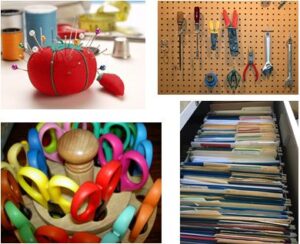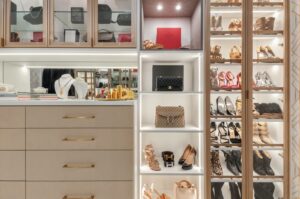What is your Organizing Personality?
Back in 2008, one of the first posts on this blog discussed the concept of individuals having a unique organizing personality. Through nine years or working with clients, understanding the individual organizing personality has become even more important to the success of my work with clients.
Processing Modality Traits
The organizing personality includes many traits. Those most frequently discussed amongst organizers are the processing modalities or sensory modalities that one uses to process information and learn from stimulus in the environment. In her book Processing Modalities Guide: Identify and Use Specific Strengths for Better Functioning … for Organizers, Coaches – and Those Who Want to Live with More Ease and Effectiveness – and Less Frustration, Denslow Brown provides a full discussion of the difference between how sensitive we are to stimuli (you become irritable in a noisy room) and how competent we are (you learn best through hearing new information). Some organize best by seeing, some by hearing or talking to themselves and some by actually moving objects around or touching them.
Piler, Filer, Tosser, Dropper Traits
Other traits include how you like to put objects together. Some like to file while other prefer to toss. Are you a tosser who like to “toss” items into a storage bin/basket/file/drawer? Children are frequently in what I call the “toss and drop” stage of their lives and would be most organized with open bins to toss and drop their belongings into. The pilers, prefer a collection of piles and are very adept at remembering what is in each pile of objects. This is frequently seen in the office setting and a common way of handling large amounts of paper. Early on in my organizing career I identified the filer when working with a client in the editorial industry. Their preference was to file as much as possible – not just the paper – into a filing cabinet by alpha order.
The Tool Maven
Some individuals find that time is a key sorting or organizing tool. These individuals will often have their files, to-do lists and projects organized by date due, date received, age or some other sense of time. Others prefer grouping, sorting and containing by another common element such as size, to whom an object relates or the special meaning of an object.
Why Does it Matter? What Does it Mean?
By understanding one’s organizing personality, one is able to develop organizing systems that more closely meet their natural organizing tendencies and will more likely be successful and sustainable. A mismatch will lead to systems which don’t get used and processes which fall apart with the resulting disorganization and frustration that ensues.
How do I Know What is my Organizing Personality?
To determine your personality, take note of how you sort, contain and retrieve items. Do you talk out loud (auditory)? Do you like to sort your files by colour (visual)? So you like to sort by date? Do you prefer all your surfaces to be clear but don’t care about the inside of your drawers or cupboards? Maybe you need everything out where you can see it (visual). Or would you rather get up and file or toss things in your office (kinetic)? Would you put everything you could into a filing cabinet? See if you can identify your own traits and then gradually modify your organizing strategies to match these traits.



Leave a Reply